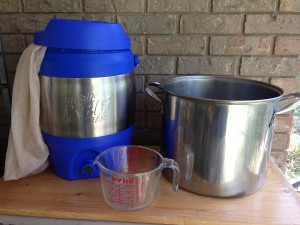
Here’s what you need to brew this, in addition to your normal extract brewing equipment — a 3-gallon (11-L) beverage cooler and a large grain steeping sack. A relatively big brewpot, like the 5-gallon (19-L) one in the picture, is also needed.
Here’s Krampus Klaws, a 14% ABV holiday lager that’s very reminiscent of Samichlaus, in a stovetop extract formulation. To brew this, you’ll need a 3-gallon (11-L) beverage cooler (the kind with a spigot for serving drinks) and a grain bag large enough to hold 6.0 lbs. (2.7 kg) of malt. (The recipe uses a small partial mash. This is completely explained in the procedures, in case you’ve never done a partial mash before.)
For best results, you’ll also need to be able to boil 3.5 gallons (13 L) of beer. In other words, you’ll need a 5-gallon (~20-L) brewpot. The biggest key to successfully brewing this beer is raising enough yeast (in your yeast starter) and holding the fermentation temperature as constant as possible.
Krampus Klaws
Strong holiday lager
by Chris Colby
Extract (partial mash); English units
DESCRIPTION
A strong, malty holiday lager.
INGREDIENTS (for 5.0 gallons)
Water
adjust so mash pH falls into 5.2–5.4 range
Malt (for an OG of 1.136 and 15 SRM)
1 lb. 10 oz. Pilsner malt
2.5 lbs. Vienna malt
1 lb. 2 oz. Munich malt
5.0 oz. aromatic malt
7.0 oz. CaraMunich III malt (60 °L)
5.0 lbs. cane sugar
6.5 lbs. light dried malt extract
Hops (for 27 IBUs total)
German Magnum hops (24 IBUs)
0.50 oz. (at 12% alpha acids), boiled for 75 minutes
Tettnanger hops (3 IBU)
0.50 oz. (at 5% alpha acids), boiled for 10 minutes
Yeast (for an FG of 1.027 and 14% ABV)
White Labs WLP885 (Zurich Lager) yeast
(2.6-gallon yeast starter)
Other
0.75 tsp. Irish moss, boiled for 15 minutes
0.25 tsp. yeast nutrients, boiled for 15 minutes
0.25 tsp. yeast nutrients, add at high kräusen
PROCEDURES
Make yeast starter 3 days ahead of brewday from 1 lb. 2 oz. of dried light malt extract. This makes approximately 2.6 gallons of wort at 1.020. You can make the starter in your fermenter, if needed. Aerate the wort thoroughly and pitch the tube of yeast. Ferment starter at 65–68 °F. Each day, aerate wort again for about 30 seconds (if using oxygen) or 3 minutes (if using air). Swirl starter several times a day. To let the yeast settle, let starter beer sit undisturbed for 12 hours prior to brewing. Cooling the starter (for example, if your fermentation chamber) would help.
On brewday, heat 8.2 qts. of brewing liquor to 159 °F. Place the 6.0 lbs. of crushed grains in a large steeping bag, put the bag in the 3-gallon cooler, stir in hot water and mash grains at 148 °F for 60 minutes. While grains are mashing, heat 2.0 gallons of sparge water to 190 °F. Recirculate the wort for 20 minutes, or until it clears significantly, whichever comes first. Do this by running off 2 cups of wort and pouring it gently back on top of the grain bed. After 30 seconds, repeat. Collect around 3.5 gallons of wort by first running off 2 cups of wort and pouring it into your brewpot. Then, gently add 2 cups of 190 °F sparge to top of grain bed. Wait about 30 seconds to 1 minute then repeat. Keep repeating until you collect the total wort volume. Once you run out of sparge water, just drain the grain bed. Do not let grain bed temperature exceed 168 °F. (Cool your sparge water, if needed, by adding cool tap water.) Do not heat wort in brewpot as you are collecting it. When you’ve collected the roughly 3.5 gallons of wort, stir in roughly half of the malt extract and heat the wort to 140 °F. Hold at this temperature for 20 minutes, then heat wort to a boil. Boil the wort hard for 60 minutes. If hot break does not appear as big, fluffy flakes after first 10 minutes of boil, add 0.25 tsp. each of calcium chloride and gypsum. Do not let boil volume dip below 3.5 gallons. Add boiling water to top up, if necessary. Add hops, Irish moss and yeast nutrients at times indicated. Stir in remaining malt extract in last 20 minutes of the boil. Take a separate small pot and dissolve some malt extract with wort from your brewpot to make it easier to stir in and avoid scorching. Dissolve a portion of your malt extract at a time and repeat until it’s all gone. Stir in sugar, using the same method, once malt extract is stirred in. Cool wort to 50 °F. Pour starter beer out of yeast starter. If you made the starter in your fermenter, rack chilled wort onto yeast. Add cold water to make 5.0 gallons and aerate wort thoroughly. (Pitch yeast after aeration if you made your yeast starter in a vessel other than your fermenter.) Ferment at 53 °F. At high kräusen, dissolve the second dose of yeast nutrients in as little water as possible. Heat mixture to 170 °F and hold for 5 minutes to sanitize. Cool and stir into fermentation. When fermentation slows to a crawl, allow temperature to rise to 60 °F and swirl fermenter to rouse yeast. (Do this only once.) Let sit at 60 °F for 3 days once evidence of fermentation (airlock bubbling) stops. Rack beer to a secondary fermenter with little or no headspace and let lager (at refrigerator temperature, around 42 °F) for at least 4 months. When finished, rack to keg and carbonate to 2.3 volumes of CO2.
Krampus Klaws
Strong holiday lager
by Chris Colby
Extract (partial mash); metric units
DESCRIPTION
A strong, malty holiday lager.
INGREDIENTS (for 19 L)
Water
adjust so mash pH falls into 5.2–5.4 range
Malt (for an OG of 1.136 and 15 SRM)
730 g Pilsner malt
1.1 kg Vienna malt
510 g Munich malt
140 g aromatic malt
200 g CaraMunich III malt (60 °L)
2.3 kg cane sugar
3.0 kg light dried malt extract
Hops (27 IBUs)
German Magnum hops (24 IBUs)
14 g (at 12% alpha acids), boiled for 75 minutes
Tettnanger hops (3 IBU)
14 g (at 5% alpha acids), boiled for 10 minutes
Yeast (for an FG of 1.027 and 14% ABV)
White Labs WLP885 (Zurich Lager) yeast
(10-L yeast starter)
Other
0.75 tsp. Irish moss, boiled for 15 minutes
0.25 tsp. yeast nutrients, boiled for 15 minutes
0.25 tsp. yeast nutrients, add at high kräusen
PROCEDURES
Make yeast starter 3 days ahead of brewday from 510 g of dried light malt extract. This makes approximately 10 L of wort at 1.020. You can make the starter in your fermenter, if needed. Aerate the wort thoroughly and pitch the tube of yeast. Ferment starter at 18–20 °C. Each day, aerate wort again for about 30 seconds (if using oxygen) or 3 minutes (if using air). Swirl starter several times a day. To let the yeast settle, let starter beer sit undisturbed for 12 hours prior to brewing. Cooling the starter (for example, if your fermentation chamber) would help.
On brewday, heat 3.9 L of brewing liquor to 71 °C. Place the 2.7 kg of crushed grains in a large steeping bag, put the bag in the 11-L cooler, stir in hot water and mash grains at 64 °C for 60 minutes. While grains are mashing, heat 7.6 L of sparge water to 88 °C. Recirculate the wort for 20 minutes, or until it clears significantly, whichever comes first. Do this by running off 2 cups of wort and pouring it gently back on top of the grain bed. After 30 seconds, repeat. Collect around 13 L of wort by first running off 2 cups of wort and pouring it into your brewpot. Then, gently add 2 cups of 88 °C sparge to top of grain bed. Wait about 30 seconds to 1 minute then repeat. Keep repeating until you collect the total wort volume. Once you run out of sparge water, just drain the grain bed. Do not let grain bed temperature exceed 76 °C. (Cool your sparge water, if needed, by adding cool tap water.) Do not heat wort in brewpot as you are collecting it. When you’ve collected the roughly 13 L of wort, stir in roughly half of the malt extract and heat the wort to 60 °C. Hold at this temperature for 20 minutes, then heat wort to a boil. Boil the wort hard for 60 minutes. If hot break does not appear as big, fluffy flakes after first 10 minutes of boil, add 0.25 tsp. each of calcium chloride and gypsum. Do not let boil volume dip below 13 L. Add boiling water to top up, if necessary. Add hops, Irish moss and yeast nutrients at times indicated. Stir in remaining malt extract in last 20 minutes of the boil. Take a separate small pot and dissolve some malt extract with wort from your brewpot to make it easier to stir in and avoid scorching. Dissolve a portion of your malt extract at a time and repeat until it’s all gone. Stir in sugar, using the same method, once malt extract is stirred in. Cool wort to 10 °C. Pour starter beer out of yeast starter. If you made the starter in your fermenter, rack chilled wort onto yeast. Add cold water to make 19 L and aerate wort thoroughly. (Pitch yeast after aeration if you made your yeast starter in a vessel other than your fermenter.) Ferment at 12 °C. At high kräusen, dissolve the second dose of yeast nutrients in as little water as possible. Heat mixture to 77 °C and hold for 5 minutes to sanitize. Cool and stir into fermentation. When fermentation slows to a crawl, allow temperature to rise to 16 °C and swirl fermenter to rouse yeast. (Do this only once.) Let sit at 16 °C for 3 days once evidence of fermentation (airlock bubbling) stops. Rack beer to a secondary fermenter with little or no headspace and let lager (at refrigerator temperature, around 5.5 °C) for at least 4 months. When finished, rack to keg and carbonate to 2.3 volumes of CO2.


Speak Your Mind